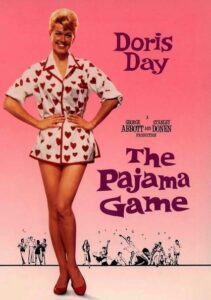The Pajama Game-1957
Director George Abbott, Stanley Donen
Starring Doris Day, John Raitt
Scott’s Review #1,292
Reviewed August 19, 2022
Grade: B+
Doris Day, the queen of the romantic comedy film during the 1950s and 1960s, was riding high in 1957 when The Pajama Game was adapted into film production. It had taken Broadway by storm in 1954 and achieved immeasurable success.
The actress/singer did not star in it; Janis Paige did. The film version required a Hollywood star in one of the lead roles, and since Frank Sinatra turned down the male lead role, Paige was fired in favor of Day.
This hurts a bit, but how does the Hollywood world of box office receipts work?
Fortunately, Day can sing, as evidenced by her startling good rendition of “Que Sera, Sera” from Hitchcock’s The Man Who Knew Too Much, which won her an Oscar just a year earlier.
Set in the midwest, USA, the boss of an Iowa pajama factory hires superintendent Sid Sorokin (John Raitt) to help oppose the workers’ demand for a seven-and-a-half-cent raise.
Sid’s presence stirs the jealousy of foreman Vernon Hines, who is dating bookkeeper Gladys Hotchkiss (Carol Haney), and attracts worker “Babe” Williams (Day), a strong advocate for the pay increase.
Despite liking Babe, Sid resists the workers’ sabotage attempt and must decide whether to fire activist Babe. Predictably, the two fall madly in love amid catchy song and dance numbers.
I’m a massive fan of the musical genre, especially during the 1950s and 1960s heyday. The Pajama Game falls somewhere in the middle for me, inferior to the brilliant West Side Story (1961) and Gypsy (1962) but holding its own with other fun musicals like Guys and Dolls (1955).
Fun is a perfect adjective to describe The Pajama Game with its bright, fluffy, colorful pajama element, midwestern polite charm, and the romantic comedy bits between Babe and Sid.
This shouldn’t mean that The Pajama Game is juvenile or fluff because it’s solidly crafted and professionally made. Every musical number sounds good and is choreographed well.
It is unsurprising to learn that Bob Fosse is the choreographer, returning to the job he did on the stage production. The principal cast of the Broadway musical reprises their roles for the movie, except Paige and Stanley Prager, whose roles are played by Jack Straw.
As a result, it’s very similar to watching a stage production. Cinema performing is different from stage performing, so there are many giant voices and theatrical-style acting, which I didn’t mind at all.
This is never showcased better than when they all go on the factory picnic.
It’s important to remember that the singing and dancing shouldn’t let the viewer forget that a sneaky liberal slant emerges in the story and that a women’s liberation/progressive woman slant is exposed if the viewer looks carefully enough.
This is an excellent way to add a tidbit of worth to an otherwise story about romance.
Babe is a strong female character, but it’s not bashed over our heads; it’s simmering below the surface. Unfortunately, this may be missed by those focused only on the most prominent elements.
As entertaining as the film is, it lacks something that ranks it below other productions like West Side Story, Singin’ in the Rain, or The Music Man. This might be a lack of serious drama replaced by a corny element or the need for one significant, memorable music number.
The Pajama Game (1957) may not be the most fabulous musical, but it has enough songs and dances to satisfy a musical fan. Day envelopes the role just fine, but I’ll always wonder how Janis Paige would have done in the film role.
